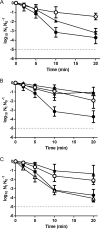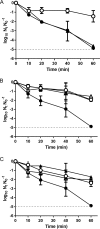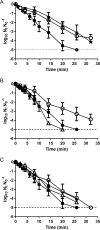Whole-Genome Sequencing and Genetic Analysis Reveal Novel Stress Responses to Individual Constituents of Essential Oils in Escherichia coli
- PMID: 29374037
- PMCID: PMC5861813
- DOI: 10.1128/AEM.02538-17
Whole-Genome Sequencing and Genetic Analysis Reveal Novel Stress Responses to Individual Constituents of Essential Oils in Escherichia coli
Abstract
Food preservation by the use of essential oils (EOs) is being extensively studied because of the antimicrobial properties of their individual constituents (ICs). Three resistant mutants (termed CAR, CIT, and LIM) of Escherichia coli MG1655 were selected by subculturing with the ICs carvacrol, citral, and (+)-limonene oxide, respectively. These derivative strains showed increased MIC values of ICs and concomitantly enhanced resistance to various antibiotics (ampicillin, trimethoprim, chloramphenicol, tetracycline, kanamycin, novobiocin, norfloxacin, cephalexin, and nalidixic acid) compared to those for the parental strain (wild type [WT]). Whole-genome sequencing (WGS) of these hyperresistant strains permitted the identification of single nucleotide polymorphisms (SNPs) and deletions in comparison to the WT. In order to analyze the contribution of these mutations to the increased antimicrobial resistance detected in hyperresistant strains, derivative strains were constructed by allelic reversion. A role of the SoxR D137Y missense mutation in CAR was confirmed by growth in the presence of some ICs and antibiotics and by its tolerance to ICs but not to lethal heat treatments. In CIT, increased resistance relied on contributions by several detected SNPs, resulting in a frameshift in MarR and an in-frame GyrB ΔG157 mutation. Finally, both the insertion resulting in an AcrR frameshift and large chromosomal deletions found in LIM were correlated with the hyperresistant phenotype of this strain. The nature of the obtained mutants suggests intriguing links to cellular defense mechanisms previously implicated in antibiotic resistance.IMPORTANCE The antimicrobial efficacy of ICs has been proven over the years, together with their potential to improve traditional heat treatments by reducing treatment intensity and, consequently, adverse effects on food quality. However, the mechanisms of bacterial inactivation by ICs are still not well understood, in contrast to antibiotics. We performed WGS of three E. coli strains that are hyperresistant to ICs. The information provided detailed insight into the mechanisms of bacterial resistance arising from exposure to carvacrol, citral, and (+)-limonene oxide. Future experiments will undoubtedly yield additional insights into genes and pathways contributing to the acquisition of endogenous resistance to ICs.
Keywords: carvacrol; citral; heat treatment; limonene; mechanisms of resistance; pulsed electric fields; whole-genome sequencing.
Copyright © 2018 American Society for Microbiology.
Figures





Similar articles
-
Sub-Inhibitory Doses of Individual Constituents of Essential Oils Can Select for Staphylococcus aureus Resistant Mutants.Molecules. 2019 Jan 4;24(1):170. doi: 10.3390/molecules24010170. Molecules. 2019. PMID: 30621156 Free PMC article.
-
Emergence of Hyper-Resistant Escherichia coli MG1655 Derivative Strains after Applying Sub-Inhibitory Doses of Individual Constituents of Essential Oils.Front Microbiol. 2016 Mar 4;7:273. doi: 10.3389/fmicb.2016.00273. eCollection 2016. Front Microbiol. 2016. PMID: 26973641 Free PMC article.
-
Oxygenated monoterpenes citral and carvacrol cause oxidative damage in Escherichia coli without the involvement of tricarboxylic acid cycle and Fenton reaction.Int J Food Microbiol. 2014 Oct 17;189:126-31. doi: 10.1016/j.ijfoodmicro.2014.08.008. Epub 2014 Aug 11. Int J Food Microbiol. 2014. PMID: 25146464
-
Harnessing Monoterpenes and Monoterpenoids as Weapons against Antimicrobial Resistance.Pol J Microbiol. 2025 Mar 7;74(1):1-18. doi: 10.33073/pjm-2025-010. eCollection 2025 Mar 1. Pol J Microbiol. 2025. PMID: 40052212 Free PMC article. Review.
-
The impact of essential oils on antibiotic use in animal production regarding antimicrobial resistance - a review.Crit Rev Food Sci Nutr. 2022;62(19):5267-5283. doi: 10.1080/10408398.2021.1883548. Epub 2021 Feb 8. Crit Rev Food Sci Nutr. 2022. PMID: 33554635 Review.
Cited by
-
Phenotypic and Genotypic Comparison of Antimicrobial-Resistant Variants of Escherichia coli and Salmonella Typhimurium Isolated from Evolution Assays with Antibiotics or Commercial Products Based on Essential Oils.Pharmaceuticals (Basel). 2023 Oct 11;16(10):1443. doi: 10.3390/ph16101443. Pharmaceuticals (Basel). 2023. PMID: 37895914 Free PMC article.
-
The Antibiotic Negamycin Crosses the Bacterial Cytoplasmic Membrane by Multiple Routes.Antimicrob Agents Chemother. 2021 Mar 18;65(4):e00986-20. doi: 10.1128/AAC.00986-20. Print 2021 Mar 18. Antimicrob Agents Chemother. 2021. PMID: 33468467 Free PMC article.
-
Sub-Inhibitory Doses of Individual Constituents of Essential Oils Can Select for Staphylococcus aureus Resistant Mutants.Molecules. 2019 Jan 4;24(1):170. doi: 10.3390/molecules24010170. Molecules. 2019. PMID: 30621156 Free PMC article.
-
Adaptive evolution of Salmonella Typhimurium LT2 exposed to carvacrol lacks a uniform pattern.Appl Microbiol Biotechnol. 2024 Dec;108(1):38. doi: 10.1007/s00253-023-12840-6. Epub 2024 Jan 4. Appl Microbiol Biotechnol. 2024. PMID: 38175235 Free PMC article.
-
Reverse engineering of fatty acid-tolerant Escherichia coli identifies design strategies for robust microbial cell factories.Metab Eng. 2020 Sep;61:120-130. doi: 10.1016/j.ymben.2020.05.001. Epub 2020 May 28. Metab Eng. 2020. PMID: 32474056 Free PMC article.
References
-
- Ait-Ouazzou A, Cherrat L, Espina L, Loran S, Rota C, Pagan R. 2011. The antimicrobial activity of hydrophobic essential oil constituents acting alone or in combined processes of food preservation. Innov Food Sci Emerg Technol 12:320–329. doi: 10.1016/j.ifset.2011.04.004. - DOI
-
- Espina L, Somolinos M, Loran S, Conchello P, Garcia D, Pagan R. 2011. Chemical composition of commercial citrus fruit essential oils and evaluation of their antimicrobial activity acting alone or in combined processes. Food Control 22:896–902. doi: 10.1016/j.foodcont.2010.11.021. - DOI
Publication types
MeSH terms
Substances
LinkOut - more resources
Full Text Sources
Other Literature Sources
Medical
Molecular Biology Databases

